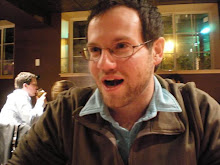Tzfat is built at the top of a hill. Instead of a grid, or a random zig-zag (which seem to me to be the predominant plans for cities) Tzfat is built in a series of concentric circles with steep alleyways/stairs in between. At the top of the mountain (2600 ft or 800 meters) in the center of the concentric streets of Tzfat, is a park.

Most of the towns, villages and cities in the States are in valleys. Or at least not at the tops of mountains. It's easier to build in valley, it's easier to get to and from places and it's easier to grow things in valleys. This all depends on the a relative peace and calm in the region. If there isn't peace and calm, it's better to be fortified and in the hills. This is the case with Tzfat and most of the old old cities in this area. Jerusalem is in the mountains (also about 2600 ft.), as is Hebron (around 3200 ft). When these cities were established the heights meant security. Today they mean beautiful views and roads that just shouldn't be roads. They twist and turn and go down steep blind curves. On the bus-ride down from Tzfat, the boy sitting three rows in front of me threw up. His father held back his peyos.
I was in Tzfat for Shabbat. Staying in a hotel for Shabbat presents a series of problems involving the prohibted activites of cooking, travelling, handling money, working, and benefiting from the work of others. They've figured out ways around most of these problems. They are somewhat creative solutions including the hiring of non-Jews to be the waiter's in the dining room. Specifically the waiters in our hotel were Israeli Arabs. Their Hebrew was heavily inflected with Arabic. Arabic inflected Hebrew is a bit easier for me to understand, because, when it is spoken slowly, it's constituent phonemes and allophones are more distinct.
For instance, Arabic has a distinction between the Alef and the Ayin (which are pronounced the same in modern Hebrew). Arabic has a distinction between the Tav and the Tet (Yiddish and Ashkenazi Hebrew also maintain a distinction but in a much different way), modern Hebrew does not. This is all an aside. The funny part is that despite the Arabic inflection of Hebrew, the servers managed to use the Ashkenazi pronunciation of all the foods they put down in front of the the Ultra-Orthodox Ashkenazi Jews from New Jersey. I'm not sure whether this was done by choice or by training, or in the immortal style of servers everywhere, in order to humor the high maintenance customers. Regardless it was a funny linguistic moment. And now it occurs to me just how much of a dork I am. Really, who thinks linguistics are funny??
The rest of Tzfat was a bit strange for me. It is ORTHODOX in the most dramatic sense of the word. I'm remarkably uncomfortable with Orthodoxy. I worry about the literalism, fundamentalism and sexism of Orthodoxy. Tzfat is also very well known for it's arts and crafts scene. But having toured the artist's market, none of it was all that special from my snobish perspective. It is also regarded as this very spiritual place, having been the home of the father of Kabbalah (Isaac Luria) and the writer of the most highly respected book of Jewish Law (Joseph Caro, The Sulchan Aruch). Because of it's "spirituality" it draws a huge number of tourist/pilgrims.
For a great number of these tourist/pilgrims, Israel has always been regarded as the center of the Jewish experience. It has not ever been the center of mine, rather, my family, New York City, matzoh ball soup and my grandmother's brisket are my Jewish center. I go to places like Tzfat and as the other tourist/pilgrims kvell about how beautiful the city is, I wonder why there's trash everywhere and why it's so dirty. As they extoll how spiritual it is and how welcoming everyone is, I try to refrain from mentioning that most of the inhabitants of Tzfat are very wary of outsiders and try to avoid eye contact...unless that is you're in their market stall and thinking about spending money. At least we all agree that the view from mountain is stunningly gorgeous.

Alright, you're probably wondering about the name of this blog entry. In Tzfat, one of the artist's Studio's, I noticed this door.

It got me to thinking about vampires and the Holy Land. Something like 45% of the water supply of Israel comes from the Kinneret (the Sea of Galilee). You may recall from my last post that this is where Jesus walked on water. The Kinneret is fed by the Jordan River, which is where John the Baptist did a lot of his Baptizing, including (a bit apocryphally I think) the baptism of Jesus. This makes the Jordan River holy water, and therefor the Kinneret. And so In Israel we drink holy water all the time. Now, according to my source on Vampires (Buffy the Vampire Slayer), holy water burns vampires. This makes us the vampire equivalent of the craziest vindaloo you can imagine. Also, there is a church, mosque or synagogue on every corner, a tomb of some prophet or saint every third corner and people eat an insane amount of garlic. All this is to say that I don't think that it's entirely necessary to put garlic on your door in order to keep the vampires away.










